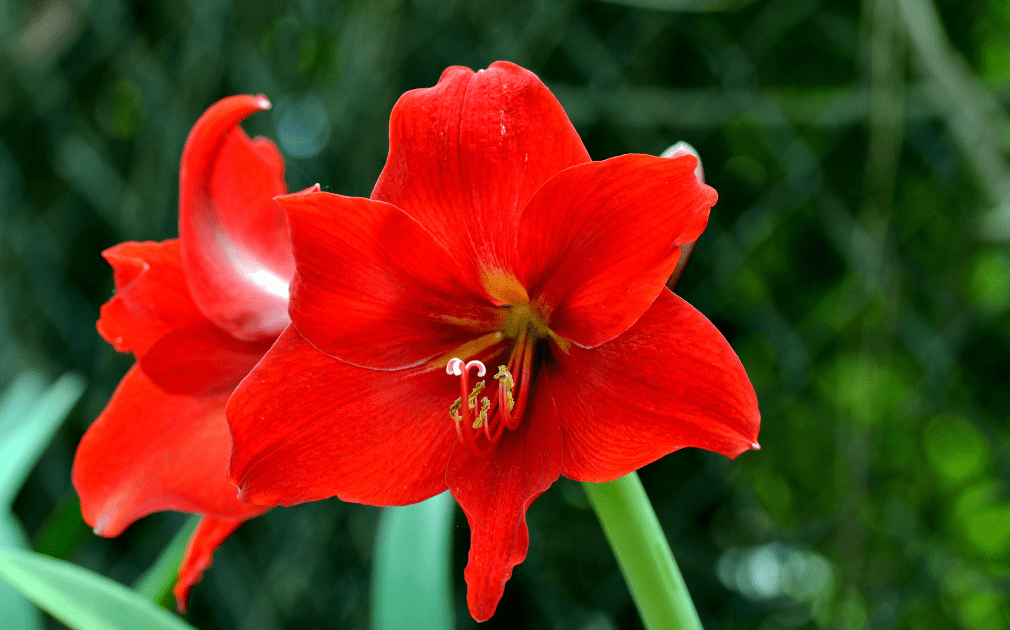Plants don’t often bloom when we tell them to, but ever since a friend gave me some instructions back in 1997, I’ve been able to get my amaryllis and Christmas cacti to bloom on demand. When I took the time to mark a few dates on my calendar and follow through, I got lovely blooms for the holiday season exactly when I wanted them. That little bit of knowledge piqued my interest, and I’ve done a bit of research since then. This post and the next convey what I’ve learned about amaryllis and Christmas cacti and controlling their bloom time. Let’s start with Amaryllis.
Amaryllis will bloom for you each year and believe it or not, you can use the same bulb for literally decades if you treat it right. These plants naturally grow in the spring and summer, and bloom in fall and winter, so we need to recreate those conditions on a timeline to get gorgeous flowers when we want them.

Timeline:
Start waking your dormant, bare bulbs 10-12 weeks before you want blooms (October 1 if planning for Christmas.) Note: If your bulb isn’t already dormant, start creating the artificial dormancy in mid-September.
Tip: For Christmas blooms, starting October 1 plant a bulb per week for 3 weeks if you want to ensure blooms happen on the desired date. Environmental conditions are naturally variable– the bulb, the soil, the moisture in the air, and a myriad of other things contribute to how fast a plant grows. Three bulbs will provide good insurance.
When purchasing an amaryllis bulb, go big. The bigger the bulb, the bigger the stems to support the blooms. Also, small bulbs may not flower for you as they may not be mature.
Potting:
- Plant your bulb in a pot that is just 1-2” wider than the diameter of the bulb. Ensure there is 2-3” soil under the bulb, and that 2/3 of the bulb is below the surface of the soil. Use a fast-draining potting soil and make sure it drains thoroughly into a saucer filled with pebbles as amaryllis are prone to root rot.
Care:
- Water the bulb directly after planting, then do not water again until you see green growth.
- Do not feed the plant after potting. If the foliage grows too fast, the stems will be leggy and weak.

- Place the pot in a bright area with indirect light, 70-75F.
- When you resume watering, keep the water away from the bulb of the amaryllis plant. Think about watering the roots below the bulb, not the bulb, and don’t be stingy with the water.
- Feed it with a high phosphorus houseplant fertilizer and water in the fertilizer.
- Every 2-3 days, turn the pot so you get straight stems.
- Your amaryllis can bloom a good 4-6 weeks if you keep it happy: 55-65 F temp in the room, bright yet indirect lighting, and moist soil that stays well drained. As the stem finishes blooming, cut it off at the base.
To keep your amaryllis bulb for next year:
- After blooming, place the plant in a spot where it will get a moderate amount of light. Water it regularly and feed it lightly on occasion, using an all-purpose houseplant fertilizer. Let the leaves continue to grow. It is important to keep the plant actively growing during the spring and summer in order to save up nutrients in the bulb that will be needed to bloom again.
- In the late spring, set the plant outdoors after danger of frost in a protected spot that gets a moderate amount of light. Harden it off, the same as any plant going outdoors. The final spot for it should be in full sun. You may choose to plant directly into the ground, or perhaps you’ll leave it in the pot because you love watering potted plants multiple times a day. Continue watering and feed lightly every two weeks.
- Mid-August: Stop feeding the plant and cut back on the water.
- Mid-September: Force your bulb into dormancy.
- Place the plant in a totally dark, cool place such as a garage or basement, or in a box in a closet. 45-55F is your target temperature. If your bulb is potted, you can leave it in the pot or remove it from the pot. If you had planted your bulb in the ground outside, gently brush off the soil and leave it bare-root.
- Leave it unattended for 6-8 weeks. The 6-8 week dormancy period is mandatory and your plant will not rebloom without it.
- Mark your calendar so your bulb doesn’t get forgotten.
- October 1: Wake up your plant and encourage it to flower as described above.
You should have wonderful blooms for Christmas!
Stay tuned for an upcoming post on Christmas cacti.
Juli Pomainville is a Master Gardener Volunteer who has been growing flowers and vegetables in Pierrepont since she was a child in 4-H. She enjoys experimenting with trendy gardening techniques, tending an annual flower garden for residents at a local nursing home, and teaching Seed to Supper classes for beginning gardeners.
